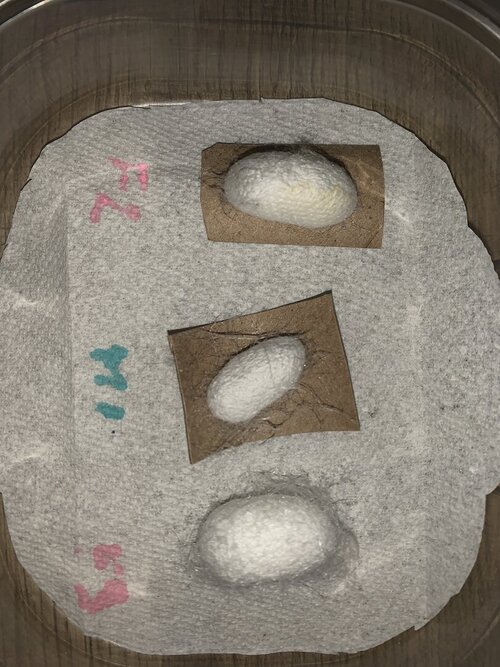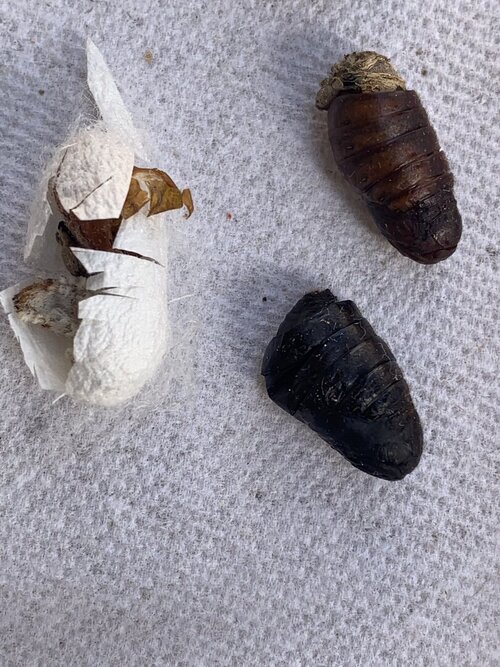cruz.m
Avid Member
Soooooooooo!!!!! I’m excited sorry, but I’m getting my Mist King v5.0 soon which I’m excited about. I’ve already gotten help for that so special thanks to @ERKleRose but I’m planning on breeding some feeders and want some advice from people. I plan on breeding hornworms, silkworms, and maybe dubias but I don’t think so I’m still deciding. I know how to breed the hornworms and silkworms and have researched for quite a while so now I’m taking the step to actually try it not yet but very soon (I want some extra questions answered as well as some reassurance as this is my very first time). Dubias, haven’t done much research and I’m terribly afraid of them and I don’t think I could do it so I may just stick to ordering them. I’ve been thinking of breeding superworms and bsfl but I’m not sure on that either. Anyways I have around 6 silkworms that I’m letting grow out and pupate/cocoon, and 5 hornworms that I’m letting grow out and pupate. I purchased the silkworm chow and have the 6 in a proper container that was recommended in another thread I had. I’m letting the five hornworms grow out in two separate deli cups that they came with. I will be purchasing the chow for them as well, should I buy the already pre-made or the powder and which brand? I will be using my smaller cage that my cham used to occupy for the hornworms and a mesh laundry hamper for the silks. I read that sometimes people use incubators but they are good without it as long as you still provide the correct temperatures and they will just take longer. Do you guys recommend I use one or no? I have toilet rolls ready as well for them to cocoon in, ordered gutter guard, some containers, organic soil, I’m going to order deli cups with hole lids as well, hummingbird feeder for moths etc. I don’t think I’m missing any supplies but I will double check!
Few questions:
1. What temperatures would you recommend I provide for both the hornworms and silkworms?
2. What do I feed the moths, I’m gonna use a humming bird feeder but what do I feed them, just water in the feeder?
3. How do you open the cage to collect or do anything without the moths flying out?
4. Since my cham is not old enough/big enough to eat the moths do I just discard them? Do they mate multiple times? I know sometimes other male silk moths will snatch a female even after she barely bred with a male.
5. What do you recommend I put for the moths to lay on? Like what plant? I saw that you can use a tomato plant but is there any other plant or should I use no plant at all and something else? I think saw someone mentioned you can just use paper towels or something
6. Can I see your entire setup if you do breed these insects?
7. How do you deal with so many feeders at a time cause I know that each moth will lay lots of eggs even if some of them aren’t fertile that’s a lot. Judging by their rapid growth do you just repeat the process with all the hornworms you couldn’t feed off? Like I said unfortunately my cham isn’t big enough to eat the moths yet...
I had more questions but I forgot them
Few questions:
1. What temperatures would you recommend I provide for both the hornworms and silkworms?
2. What do I feed the moths, I’m gonna use a humming bird feeder but what do I feed them, just water in the feeder?
3. How do you open the cage to collect or do anything without the moths flying out?
4. Since my cham is not old enough/big enough to eat the moths do I just discard them? Do they mate multiple times? I know sometimes other male silk moths will snatch a female even after she barely bred with a male.
5. What do you recommend I put for the moths to lay on? Like what plant? I saw that you can use a tomato plant but is there any other plant or should I use no plant at all and something else? I think saw someone mentioned you can just use paper towels or something
6. Can I see your entire setup if you do breed these insects?
7. How do you deal with so many feeders at a time cause I know that each moth will lay lots of eggs even if some of them aren’t fertile that’s a lot. Judging by their rapid growth do you just repeat the process with all the hornworms you couldn’t feed off? Like I said unfortunately my cham isn’t big enough to eat the moths yet...
I had more questions but I forgot them









